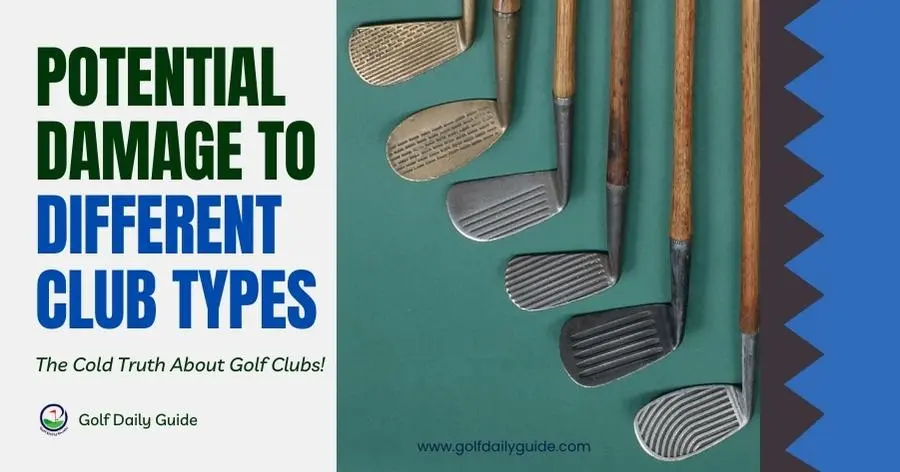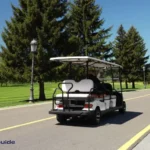Generally, leaving golf clubs in the cold can have significant consequences on their performance and durability.
Basically, the materials in the shaft and grip of the golf club can become more stupid as the temperature decreases, which affects the flexibility and feeling during the swing.
Anyway, is it bad to leave golf clubs in the cold? The cold weather can also lead to the contraction of metal clubheads, potentially affecting the overall balance and weight distribution.
In this exploration, I will discover the potential reactions to golf clubs in chilli situations and discuss the tips needed to protect your tools.
Confirm that your clubs will maintain the best performance in the weather they are in.
Is it bad to leave golf clubs in the cold?
Leaving golf clubs in the cold can adversely impact their performance and longevity. Cold temperatures can cause the materials in club shafts to become stiffer, affecting their flexibility and responsiveness during a swing.
Additionally, grips may harden, making them less comfortable and reducing the golfer’s control. Metal clubheads can contract in the cold, potentially altering their weight distribution and balance, and influencing the accuracy of shots.
Exposure to extreme cold may even lead to damage such as rust or other structural issues.
To preserve the quality and durability of your golf clubs, it’s advisable to take precautionary measures, such as storing them in a climate-controlled environment or using headcovers in colder conditions.
1. Effects Of Cold On Golf Clubs
Golf clubs are a crucial investment for any golfer, and proper care is essential to maintain their performance and longevity.
Did you know that leaving golf clubs in the cold can have detrimental effects on their condition? Let’s explore the potential damage that cold temperatures can inflict on your golf clubs.
2. Corrosion And Rust
When exposed to cold temperatures, golf clubs can be susceptible to corrosion and rust. Moisture present on the clubs can freeze, causing the metal to contract and create small cracks.
These cracks provide avenues for water to seep through, leading to the formation of rust over time.
Rust not only affects the appearance of your clubs but also compromises their performance. Rusty clubheads can hinder your swing, negatively impacting accuracy and distance.
Moreover, it can cause unnecessary wear and tear on the clubface as the rust interacts with the golf ball during impact.
3. Material Weakness
In addition to corrosion and rust, the cold can weaken the materials used in golf clubs. Various components of golf clubs, such as graphite shafts, epoxy glues, and grips, can be affected by extreme temperatures.
The cold temperature causes contraction and can lead to structural weaknesses in the graphite shafts, which may result in cracks or even breakage.
Similarly, the epoxy glues that hold the club components together can become brittle, compromising the overall durability and performance of the club.
Grips are not immune to the cold’s effects either. Exposure to low temperatures can harden the grip material, making it less comfortable to hold and reducing the golfer’s control over the club. A weakened grip can impact swing stability and diminish shot accuracy.
Potential Damage To Different Club Types
Leaving your golf clubs in the cold can potentially cause damage to different club types, impacting their performance on the course.

It’s important to be aware of this and take necessary precautions to protect your clubs:
A. Irons And Wedges:
Irons and wedges are vital clubs in your golf bag, and exposure to cold temperatures can have various effects on them.
Here are some potential damages to be aware of:
- Clubhead Rusting: The moisture from cold weather can promote rust formation on the clubheads, affecting their appearance and durability.
- Shaft Contraction: The cold air can cause the graphite or steel shafts of your irons and wedges to contract, altering their flex and potentially leading to a decrease in performance.
- Grip Hardening: The grips of your clubs may become stiff and hard when exposed to low temperatures, reducing your ability to hold and control the club effectively.
To prevent these damages, it is advisable to store your irons and wedges indoors in a temperature-controlled environment. Although I was able to inform you, Is it bad to leave golf clubs in the cold?
If you must leave them in a cold place, consider wrapping them in a protective cover or placing them in a golf bag with additional insulation.
B. Woods And Hybrids:
Woods and hybrids are designed with different materials and components compared to irons and wedges.
As a result, they too can experience potential damage when exposed to cold weather. Here are some considerations:
- Clubhead Expansion and Contraction: The clubheads of woods and hybrids can expand or contract due to temperature fluctuations, affecting the club’s alignment and potentially altering the loft and lie angles.
- Resin and Glue Integrity: The resin and glue used in the construction of woods and hybrids can be weakened in cold temperatures, compromising the structural integrity of the club.
- Loose Shaft Connections: Cold weather can cause the epoxy used to bond the shaft to the clubhead to become brittle, leading to potential loosening or separation of the components.
To protect your woods and hybrids from potential damage, it’s recommended to store them in a temperature-regulated environment, preferably indoors.
Additionally, avoid using them immediately after bringing them in from the cold, allowing time for the clubs to adjust to room temperature.
What temperature is too cold for golf clubs?
Golf clubs can be adversely affected when exposed to temperatures below freezing, typically around 32°F (0°C).
At this point, materials in club shafts and grips can become more rigid, impacting flexibility and feel during a swing.
Metal clubheads may also contract, potentially affecting the weight distribution and balance.
While golf clubs are designed to withstand a range of conditions, prolonged exposure to extreme cold can lead to performance issues and even structural damage.
To ensure optimal play, it’s advisable to store clubs in a climate-controlled environment and avoid subjecting them to prolonged periods of sub-freezing temperatures.
Preventive Measures For Cold Weather Storage
When storing your golf clubs during cold weather, taking preventive measures is crucial to preserve their quality and performance.

Follow these important steps to protect your clubs from the potential damage caused by cold temperatures:
1. Proper Cleaning And Drying
After a day on the green, ensure to clean your clubs thoroughly with a soft brush and mild soap to remove any dirt, grass, or debris.
Rinse them with water and dry them completely with a towel, paying special attention to the club heads and grips.
2. Use Of Headcovers
Investing in headcovers for your clubs is a wise decision, especially during cold weather. Covering the clubheads can prevent moisture from seeping in and causing damage.
Be sure to use headcovers for all your clubs, including your putter. Although I was able to inform you, Is it bad to leave golf clubs in the cold?
Can you play golf in the winter?
Golf can be played in the winter, but it presents unique challenges. Cold temperatures affect ball and club performance, making shots less predictable.
Courses may have winter rules and temporary greens. Proper attire, including thermal layers and waterproof gear, is essential.
Additionally, days are shorter, limiting playing time. Some golfers embrace winter golf for its serene beauty and the joy of conquering adverse conditions.
To enhance the experience, choose appropriate equipment, check course conditions, and be mindful of weather forecasts.
Winter golf offers a different but rewarding experience for those willing to adapt to the seasonal nuances.
Tips For Cold Weather Play
In cold weather, it’s best to avoid leaving your golf clubs outside for long periods as extreme temperatures can affect the materials and performance.
Store them in a temperature-controlled environment to prevent damage and maintain their quality for better play:
Pre-round Club Warm-up:
Golf clubs that have been left out in the cold may not perform at their best.

To ensure optimal performance, follow these tips for warming up your clubs before heading out to the course:
1. Before leaving your clubs in a cold environment, such as a garage or car trunk, wipe them down with a soft cloth to remove any moisture.
This will help prevent rust and damage to the clubheads. Although I was able to inform you, Is it bad to leave golf clubs in the cold?
2. Once you arrive at the golf course, give your clubs some extra attention to warm them up. Start by taking a few practice swings, gradually increasing the speed and intensity. This will allow the club heads to loosen up and regain their flexibility.
3. Pay special attention to the club grip, as it can become stiff and uncomfortable in cold weather.
To warm it up, rub it briskly between your hands or use a hand warmer to provide some heat. This will help maintain a better grip on the club throughout your round.
4. Before teeing off, take a few moments to inspect each club and ensure that there are no visible signs of damage or wear.
Cold weather can exacerbate any existing issues, so it’s important to address them before starting your round.
Use Of Hand Warmers:
Hand warmers can be a golfer’s best friend when playing in cold weather.
Here’s how you can make the most of them:
1. Before heading out to the golf course, activate your hand warmers by shaking them vigorously. This will help distribute the heat evenly.
2. Once activated, place one hand warmer in each pocket of your golf bag. This will keep your hands warm when they are not in use, preventing them from getting too cold.
3. When it’s time to use your clubs, take out a hand warmer and hold it in your hands for a few moments. This will help warm up the muscles in your hands and improve your grip on the club.
4. If you find that your hands are still cold during your round, you can place a hand warmer inside your golf glove. This will provide additional warmth and keep your hands comfortable throughout your game.
Remember, cold clubs can affect your swing and overall performance on the golf course. By following these tips for pre-round club warm-up and using hand warmers, you can mitigate club heads and grips.
Store clubs in a standing position to maintain the negative effects of cold weather on your game.
So, don’t let the cold stop you from enjoying a round of golf – prepare your clubs and stay warm to play your best.
How do you store golf clubs in the winter?
Properly storing golf clubs in winter is crucial for maintaining their performance. Keep them indoors in a climate-controlled space to avoid exposure to extremely cold temperatures.
Before storage, clean the clubs thoroughly, removing any dirt or moisture. Apply a thin layer of oil to metal clubheads to prevent rust.
Use headcovers to protect their shape. Avoid leaving them in the trunk of a car or any place where temperatures can fluctuate dramatically.
Regularly check and recondition grips, ensuring they remain supple and ready for play when the golfing season returns.
Long-term Effects And Maintenance
Leaving your golf clubs in the cold can have long-term effects and may require extra maintenance.
The cold temperatures can cause damage to the club’s shaft, grip, and overall performance. It’s important to store your clubs properly and avoid extreme cold conditions to ensure their longevity.
Leaving golf clubs in the cold can have long-term effects on their performance and durability. Understanding how the cold affects your clubs is crucial in maintaining their condition and extending their lifespan.

Regular inspection and maintenance are essential to avoid potential damage and ensure optimal club performance.
Regular Inspection And Maintenance:
Regularly inspecting your golf clubs is key to spotting any issues caused by exposure to the cold.
Inspect the grips, shafts, and heads to identify signs of damage such as cracks, dents, or warping. Be thorough and check each club individually.
Pay close attention to the connections between the shafts and clubheads. If you notice any abnormalities, take action promptly to prevent further damage.
Impact On Club Performance:
The cold temperatures can affect the performance of your golf clubs in several ways. One of the main concerns is the potential for the shafts to become more brittle in the cold.
This can cause them to lose their flexibility, leading to decreased power and accuracy in your swings.
Additionally, extreme cold can also affect the grip material, causing it to harden and lose its stickiness.
This can result in a compromised grip and difficulty maintaining control of the club during your swing. Although I was able to inform you, Is it bad to leave golf clubs in the cold?
Moreover, leaving your clubs in a cold environment for extended periods can also result in rust and corrosion, particularly on the clubheads.
Rust not only affects the appearance of your clubs but can also impact their performance. The buildup of rust on the clubface can alter the spin and trajectory of the ball, leading to inconsistent shots.
Given these potential issues, proper maintenance is crucial to mitigating the effects of the cold on your golf clubs. Storing them in a cool, dry place, away from extreme temperature fluctuations, is essential.
Additionally, cleaning and drying your clubs after every round of play is vital to prevent moisture from seeping into the club heads or shafts.
Furthermore, to maintain the grips’ performance and prevent them from hardening in the cold, consider using grip covers or protective sleeves when not in use.
These accessories provide an extra layer of insulation and help preserve the integrity of the grips.
Overall, while it is not necessarily “bad” to leave golf clubs in the cold, it is essential to take proper care of them to avoid potential long-term damage.
Regular inspection, maintenance, and storing practices are vital to ensure optimal performance and extend the lifespan of your golf clubs.
Do golf clubs need to be stored inside?
Storing golf clubs indoors is highly recommended, especially during the winter. Extreme temperatures, both hot and cold, can adversely affect the materials in golf clubs, potentially impacting their performance and longevity.
Storing clubs in a climate-controlled environment helps prevent issues like grip hardening, shaft stiffness, and damage to clubheads.
It also safeguards them from exposure to moisture, which can lead to rust and other forms of deterioration.
By keeping golf clubs indoors, you ensure that they remain in optimal condition, ready for peak performance when you’re ready to hit the links.
How long can you leave golf clubs in water?
Leaving golf clubs in water is not advisable, as prolonged exposure can lead to irreversible damage.
Water can seep into club heads and shafts, causing rust, corrosion, and degradation of materials.
The grips may also absorb water, leading to mold, mildew, and a loss of their intended feel and performance.
If golf clubs accidentally end up in water, it’s essential to retrieve them promptly, thoroughly dry them, and inspect for any signs of damage.
Proactive measures, such as using headcovers and avoiding water hazards, can help prevent potential harm and prolong the lifespan of your golf clubs.
Frequently Asked Questions For Is It Bad To Leave Golf Clubs In The Cold?
Can Leaving Golf Clubs In The Cold Damage Them?
Leaving golf clubs in the cold for prolonged periods can cause damage. Extreme temperatures can weaken the materials used in clubs, affecting their performance and durability. It’s best to store your golf clubs in a temperature-controlled environment to maintain their condition.
How Does Cold Weather Affect Golf Club Performance?
Cold weather affects golf club performance by reducing the flexibility of club materials. This can result in less distance and control when hitting shots.
Additionally, cold temperatures can shrink the grip, making it harder to hold the club securely. It’s important to adjust your swing and club selection accordingly in colder conditions.
What Is The Ideal Temperature For Storing Golf Clubs?
The ideal temperature for storing golf clubs is between 60°F and 80°F (15°C and 26°C). This temperature range helps preserve the materials of the clubs and prevents any potential damage.
Avoid storing clubs in extremely cold or hot environments to ensure their longevity and performance. Although I was able to inform you, Is it bad to leave golf clubs in the cold?
Related Post
How to tell if a golf ball is waterlogged
What is an ostrich in golf
How many dimples in a regulation golf ball
Why golf cart cranks but won’t start
How to winterize electric golf cart
Conclusion
In conclusion, leaving golf clubs out in the cold poses a risk to their performance and longevity. Cold temperatures can affect shaft flexibility.
Can tighten the grip and change the balance of the metal clubhead. These changes can affect the overall feel and accuracy of your shots.
To preserve the quality of your golf clubs, it is recommended to store them in a climate-controlled environment when not in use during the colder months.
Taking proactive measures, such as regular cleaning, proper storage, and using headcovers, ensures your clubs are in optimal condition, and ready to deliver peak performance when you step on the golf course.












